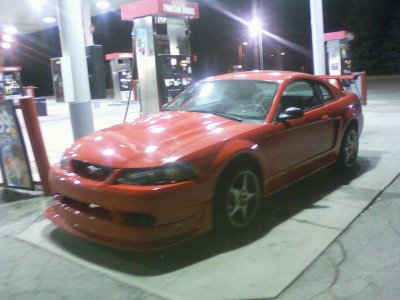He said it was real. He didn't get off his cell phone so I didn't check it out any better, It had the side exit exhaust, wing, hood, wheels and splitter. He was an older guy dressed nice on phone but maybe it wasn't. Not 100 % sure.
2000 Cobra R
In 2000, the Cobra R returned for a production run of 300 units (effectively taking the place of the standard Cobra for that model year) with a 5.4L DOHC engine (6500 rpm redline) that was rated at 385 hp (287 kW) and 385 lbf·ft (522 N·m) of torque, although independent dyno tests have shown that it produced rear-wheel output that nearly matched both of those numbers, suggesting the engine may have been underrated. The iron block was based on the 5.4l block Ford uses in its trucks. The cylinder heads were later used in the Ford GT (slightly modified). Some sources claim that the Australian Ford Falcon GT's engine is very similar to the one of the 00 R. As before, this model was designed to be a race-ready high-performance vehicle in a perfectly street legal package; as such, it lacked many of the comforts the base production line Cobra enjoyed. This model had no radio/audio equipment, no air conditioning, no cruise control and no rear seat. Each of the 300 produced featured a charcoal interior with cloth clad Recaro buckets and sporting a Performance Red exterior.
The limited edition 2000 Cobra R
The 2000 Cobra R had several distinguishing visual and performance features that allow one to easily identify it as something more than a normal 1999 or 2001 Cobra. The "power dome" hood for instance, is taller than the normal Cobra hood, and has gills that can be cut out to reduce engine compartment temperatures. The rear spoiler is tall and wide, providing much needed down force at track speeds. The 2000 Cobra R is equipped with Eibach springs that lower the car 1.5 inches in front and 1.0 inch out back. This model also uses Bilstein shocks and struts, Brembo 4-piston front calipers acting on 13 inch rotors cooled by large ducts, along with a race-style fuel cell that is clearly visible protruding under the V6-style rear diffuser. This fuel cell also was the reason for the side exhaust used on this model, since the tank was too large and the normal exhaust would not have fitted. The front bumper is adorned with a low riding, removable splitter. The wheels are also uniquely styled silver five spoke 18-inch (460 mm) x 9.5-inch (240 mm) alloys wrapped in aggressive BF Goodrich G-Force KD tires. The hand built SVT engine employes special DOHC cylinder heads, a "Trumpet-style" intake manifold, aggressive camshafts, short tube headers, and connected to Cobra catalysts, a Bassani X-pipe, and a unique Borla dual side exiting exhaust system. This model also features 3.55 gears, a Gerodisc hydro-mechanical differential with speed and torque sensitivity, and a Tremec T-56 6-speed transmission that is closely geared for drag racing or road course usage. Despite these close ratios, the 2000 Cobra R also enjoyed a 175.3 mph (282 km/h) top speed. The car was developed with the extensive help of Jack Roush, who did lots of work on the fine tuning, and suggesting parts.
With its sharp styling, stiff suspension, and overall aggressive engineering, SVT fulfilled the 2000 Cobra R's intent of a pure sport and track car.
"This limited-edition, 385-horse pony runs 12s and pulls 1.01g!... Our acceleration tests revealed steam catapult-like launches with 60 mph arriving in just 4.4 seconds... That compares favorably with the Corvette's 4.8-second run to 60 and 13.3 at 108.6 through the quarter mile." -Motor Trend April, 2000 Issue

